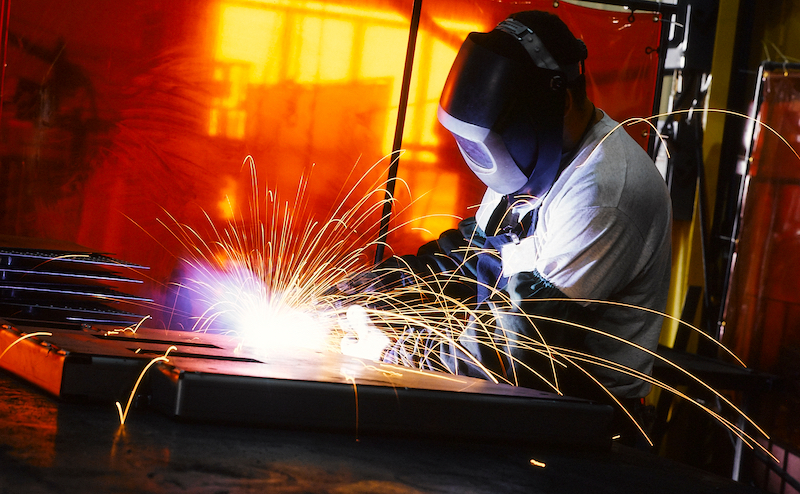
Welding helmets are essential safety gear designed to protect welders from a combination of hazards—intense visible light, ultraviolet (UV) and infrared (IR) radiation, sparks, and hot metal fragments. Without adequate protection, exposure to these dangers can lead to severe injuries such as burns, “arc eye” (a painful corneal inflammation), and even permanent vision loss.
Basic Features of Welding Helmets
A typical welding helmet consists of a durable shell that shields the face and neck, and a viewing lens that protects the eyes while allowing the user to see the material they are welding. Helmets fall into two main categories:
- Passive lens helmets: These have a fixed shade lens, dark enough for welding but too dark to see the work when welding is finished causing the welder to lift the helmet between tasks. Passive lens helmets provide all around protection at affordable costs.
- Auto-darkening helmets: This type of helmet is equipped with sensors that detect the arc’s light and automatically adjust lens shade coupled with a permanent UV and IR blocking layer. This allows welders to maintain visibility without flipping the helmet up and down to look at their work. Auto darkening helmets are generally more expensive.
Why Eye Protection Quality Matters
The heart of a welding helmet is its lens technology. A high-quality helmet will provide full UV/IR protection—whether the lens is darkened or not—preventing harmful rays from reaching the eyes.
Welding helmet manufacturers face the ongoing challenge of balancing performance, safety, and comfort while staying competitive in a fast-evolving market. As industries push for higher productivity and regulations change to provide better worker protection, the demands placed on welding helmets have grown considerably.
At the core of meeting these demands lies a crucial component that is often overlooked: the optical filter system.

The Challenge: Optical Clarity Meets Protection
Modern welding helmets must deliver superior eye protection from intense infrared and ultraviolet radiation while providing optimal visibility and color perception. With welding moving beyond traditional solutions to now include laser welding and cutting, new solutions are needed to meet the wide variety of solutions on the market.
For helmet manufacturers, the primary challenge lies in developing filters that can:
-Block harmful NIR and UV radiation effectively.
-Provides high optical clarity.
-React swiftly and reliably in diverse welding environments.
-Maintain durability and safety under extreme temperatures and prolonged use.
Creating a lens system that can meet all these criteria without adding unnecessary weight or cost has traditionally required trade-offs. This is where a high-performance dye offers a strategic advantage.
Importance of a Tailored NIR Dye for Advanced Filters
Epolin is a leader in the development of UV, Visible, and NIR-absorbing dyes. Offering a range of customizable solutions specifically engineered for polycarbonate and other thermoplastic polymers commonly used in welding filters. These dyes enable helmet manufacturers to design filters targeting specific shade values. Epolin’s extensive portfolio of laser absorbing dyes and ready-to-mold pellets also facilitate new filters designed for laser welding applications.
Key Benefits for Manufacturers:
Enhanced Protection:
These dyes provide robust absorption from 200nm to 3000 nm wavelength range, which is critical for shielding welders.
Material Compatibility:
Designed for use in thermoplastics like polycarbonate, these dyes are stable during injection molding and extrusion, simplifying the manufacturing process and allowing the creation of eyewear, helmets, goggles, and windows.
Customization and Support:
Epolin works directly with manufacturers to develop custom formulations that meet specific optical density requirements and regulatory standards, accelerating product development timelines.
Remaining Competitive in a Crowded Market
With growing competition in the personal protective equipment (PPE) sector, helmet manufacturers must continually differentiate their products. Epolin’s dyes offer a cost-effective way to elevate helmet performance without overhauling existing production lines. By enabling lighter, clearer, and more effective filters, manufacturers can meet rising customer expectations and regulatory demands—while preserving their bottom line.
Conclusion
In a market where safety, performance, and user comfort are non-negotiable, Epolin’s advanced light management dyes provide welding helmet manufacturers with a clear path to innovation. By integrating Epolin’s dye technology into their welding systems, manufacturers can overcome their most pressing challenges and deliver next-generation welding protection that keeps them ahead of the curve. Learn more about Epolin’s welding dyes Epolin’s welding dyes here
Contact us at epolin@epolin.com.

